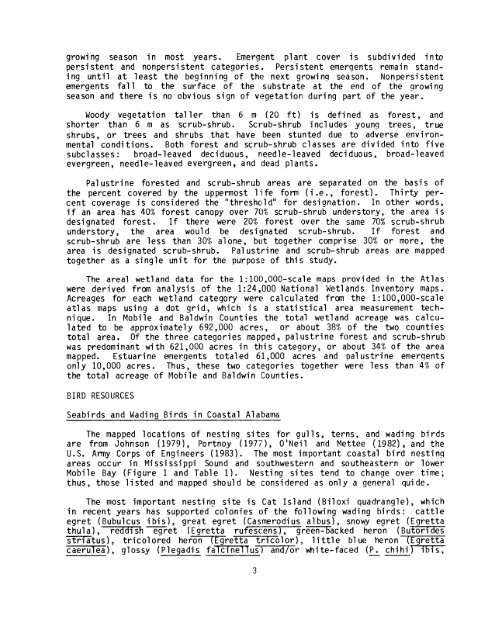ecological characterization atlas of coastal alabama - Data Center
ecological characterization atlas of coastal alabama - Data Center
ecological characterization atlas of coastal alabama - Data Center
You also want an ePaper? Increase the reach of your titles
YUMPU automatically turns print PDFs into web optimized ePapers that Google loves.
growing season in most years . Emergent plant cover is subdivided into<br />
persistent and nonpersistent categories . Persistent emergents remain standing<br />
until at least the beginning <strong>of</strong> the next growinq season . Nonpersistent<br />
emergents fall to the surface <strong>of</strong> the substrate at the end <strong>of</strong> the growing<br />
season and there is no obvious sign <strong>of</strong> vegetation during part <strong>of</strong> the year .<br />
Woody vegetation taller than 6 m (20 ft) is defined as forest, and<br />
shorter than 6 m as scrub-shrub . Scrub-shrub includes young trees, true<br />
shrubs, or trees and shrubs that have been stunted due to adverse environmental<br />
conditions . Both forest and scrub-shrub classes are divided into five<br />
subclasses : broad-leaved deciduous, needle-leaved deciduous, broad-leaved<br />
evergreen, needle-leaved evergreen, and dead plants .<br />
Palustrine forested and scrub-shrub areas are separated on the basis <strong>of</strong><br />
the percent covered by the uppermost l-ife form (i .e ., forest) . Thirty percent<br />
coverage is considered the "threshold" for designation . In other words,<br />
if an area has 40% forest canopy over 70% scrub-shrub understory, the area is<br />
designated forest . If there were 20% forest over the same 70% scrub-shrub<br />
understory, the area would be designated scrub-shrub . If forest and<br />
scrub-shrub are less than 30% alone, but together comprise 30% or more, the<br />
area is designated scrub-shrub . Palustrine and scrub-shrub areas are mapped<br />
together as a single unit for the purpose <strong>of</strong> this study .<br />
The areal wetland data for the 1 :100,000-scale maps provided in the Atlas<br />
were derived from analysis <strong>of</strong> the 1 :24,000 National Wetlands Inventory maps .<br />
Acreages for each wetland category were calculated from the 1 :100,000-scale<br />
<strong>atlas</strong> maps using a dot grid, which is a statistical area measurement technique<br />
. In Mobile and Baldwin Counties the total wetland acreage was calculated<br />
to be approximately 692,000 acres, or about 38% <strong>of</strong> the two counties<br />
total area . Of the three categories mapped, palustrine forest and scrub-shrub<br />
was predominant with 621,000 acres in this category, or about 34% <strong>of</strong> the area<br />
mapped . Estuarine emergents totaled 61,000 acres and palustrine emerqents<br />
only 10,000 acres . Thus, these two categories together were less than 4% <strong>of</strong><br />
the total acreage <strong>of</strong> Mobile and Baldwin Counties .<br />
BIRD RESOURCES<br />
Seabirds and Wading Birds in Coastal Alabama<br />
The mapped locations <strong>of</strong> nesting sites for gulls, terns, and wading birds<br />
are from Johnson (1979), Portnoy (1977), O'Neil and Mettee (1982), and the<br />
U .S. Army Corps <strong>of</strong> Engineers (1983) . The most important <strong>coastal</strong> bird nesting<br />
areas occur in Mississippi Sound and southwestern and southeastern or lower<br />
Mobile Bay (Figure 1 and Table 1) . Nesting sites tend to change over time ;<br />
thus, those listed and mapped should be considered as only a general quide .<br />
The most important nesting site is Cat Island (Biloxi quadrangle), which<br />
in recent years has supported colonies <strong>of</strong> the following wading birds : cattle<br />
egret (Bubulcus ibis ), great egret (Casmerodius albus), snowy egret (Egretta<br />
thula), rec fcisi egret (Egretta rufesc:ens , green--Facked heron (Butori es<br />
st ir atus), tricolored heron Egretta tricolor), little blue heron Egretta<br />
caerulea), glossy ( Plegadis fa c~ineTTus and or white-faced (P . chihi i is,<br />
3
















